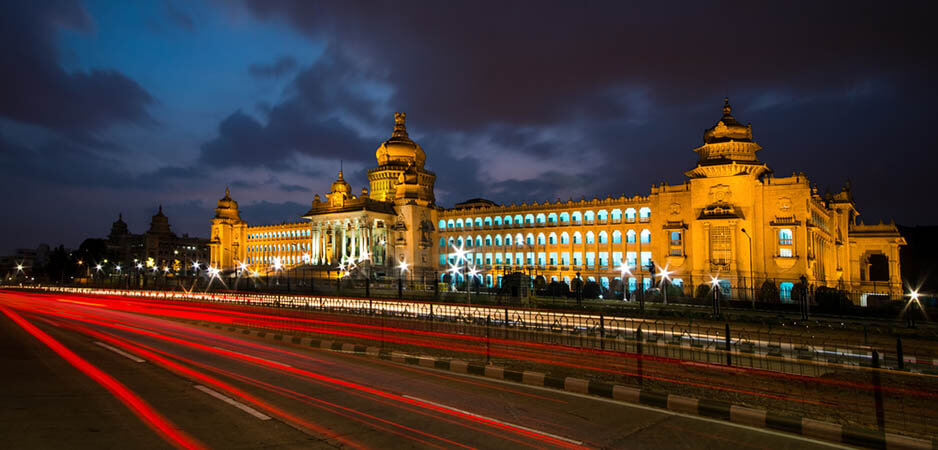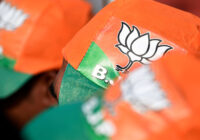In the fourth of a five-part series on opinion polls about the forthcoming Indian elections, pollsters concur that regional parties hold sway in the south, but disagree as to seat numbers and the implications for the next national government.
South India has a different historical memory to the rest of the country. Neither the Mauryan Empire of ancient times, nor the Mughal Empire of medieval times ruled the south entirely. Only under the British Empire was the south knit together with the north politically. In a discussion on the forthcoming elections conducted by Yogendra Yadav and Sanjay Kumar of the Centre for the Study of Developing Societies (CSDS) and this author, the south is perhaps where we disagree most.
For this series, we have Shekhar Gupta to thank for inviting us to air our views, even though he failed to keep his word and publish my work. As a result, Fair Observer has agreed to publish me.
THE YADAV CRYSTAL BALL FOR SOUTH INDIA
Yogendra Yadav argues that the national parliamentary elections in the south cannot be on the presidential pattern as in the north. Here, the Bharatiya Janata Party (BJP) cannot project Prime Minister Narendra Modi against Rahul Gandhi, president of the Indian National Congress. This means the election will perforce revolve around regional issues and local personalities.
Yadav points out that the BJP has low stakes in the region. It won a mere 22 seats in the south, of which 17 came from the state of Karnataka alone. In Yadav’s estimation, the BJP will continue to be a marginal player in this region. In the state of Tamil Nadu, M. Karunanidhi, the longstanding leader of the Dravida Munnetra Kazhagam (DMK), is dead. So, is his bitter rival Jayalalithaa of the All India Anna Dravida Munnetra Kazhagam (AIADMK). The DMK and AIADMK have dominated Tamil Nadu for decades. Neither the Congress nor the BJP have been able to hold sway in this most proud of southern states. Yadav argues that the BJP’s attempt to acquire the AIADMK in the post-Jayalalithaa era has failed spectacularly. The anti-BJP DMK seems to be in the ascendant after two terms of AIADMK rule.
As per Yadav, the BJP might fare a bit better in the state of Kerala. Here, it is stirring primal passions over the controversy over the Sabarimala Temple. This might lead to a breakthrough in electoral representation in Kerala. However, the first-past-the-post (FPTP) system is likely to lead to higher vote share, but not necessarily seats in the national parliament.
He argues that the BJP-led National Democratic Alliance (NDA) might not fare well in the states of Andhra Pradesh and Telangana. Chandrababu Naidu, the chief minister of Andhra Pradesh and leader of the Telugu Desam Party (TDP), is forging a broad-based front against the BJP. Telangana Chief Minister K. Chandrashekar Rao of the Telangana Rashtra Samithi (TRS) has declared he is “a warrior, not a beggar” and hit out at both national parties. For Rao, both the Congress and the BJP centralize power in New Delhi instead of delegating it to the states. Therefore, he is trying to create a national third front of regional parties to challenge the two dominant national players and this might play out well with his voters.
Yadav predicts that the BJP might lose its hold on Karnataka as well. In the 2018 elections for the state legislative assembly, the saffron party won 104 seats and emerged as the largest party in the state. However, the Indian National Congress with 80 seats and Janata Dal (Secular) with 37 seats combined to keep the BJP out of power in Karnataka. It is important to note that the BJP did not get the highest vote share. It managed only 36.3% of the vote as compared to 38.1% for the Congress party. In the forthcoming national elections, the BJP faces a coalition of Congress and Janata Dal (Secular), making a landslide defeat a distinct possibility because the latter garnered 18.3% of the vote.
Yadav estimates that the Bharatiya Janata Party might lose five to 10 seats in the south. This means that it is likely to win a mere 10-17 seats in this part of the country, making it a marginal party in the south.
YADAV IS RIGHT ON BIG PICTURE, NOT ON DETAILS
It is hard to disagree with the broad thrust of Yadav’s analysis. However, the devil lies in the details and pollsters know that fine margins lead to victories or defeats. The Congress party is certainly likely to gain seats, but this is unlikely to occur in Karnataka. Instead, it will gain a boost in Kerala and Telangana.
In Kerala, there is a big upswing in support for the BJP. CVoter Tracker reveals that the BJP might win 17% of the vote, but it needs a further 5% swing to win a single seat in the state. This is possible but not probable. More importantly, the BJP is rising in Kerala by whittling away the vote share of the communist-led Left Front. This is deeply ironic because it is in Kerala that the first democratically elected communist government in the world assumed office in 1957. Yet the FPTP system means that the BJP will not benefit from this increased vote share. Ironically, it will only help its national rival, the Congress, to sweep the state. As per CVoter Tracker data, the Congress would gain eight seats and allies of its United Progressive Alliance (UPA) another four. A gain of 12 seats for the Congress-led UPA would definitely shake up politics in Kerala.
 In Andhra Pradesh, Naidu’s dumping of the BJP and embracing the Congress will lead to a loss of 18 seats for the NDA. Yet life is never uninteresting in Indian politics. Another regional party named the YSR Congress Party (YSRCP) is going hammer and tongs at Naidu. Although YSRCP has declared that it will not ally with the Bharatiya Janata Party, politics makes strange bedfellows and the situation in Andhra Pradesh might not be as cast in stone as it seems.
In Andhra Pradesh, Naidu’s dumping of the BJP and embracing the Congress will lead to a loss of 18 seats for the NDA. Yet life is never uninteresting in Indian politics. Another regional party named the YSR Congress Party (YSRCP) is going hammer and tongs at Naidu. Although YSRCP has declared that it will not ally with the Bharatiya Janata Party, politics makes strange bedfellows and the situation in Andhra Pradesh might not be as cast in stone as it seems.
There is another pertinent point most pollsters forget. First, the BJP has long had a powerful presence in both Telangana and Andhra Pradesh. In 1998, the party polled 19.5% of the votes in the parliamentary elections. The Naidu-led TDP won 12 seats as compared to 22 won by the Congress. As a result, the canny Naidu entered an alliance with the BJP for the 1999 elections. It is important to note that the BJP sacrificed Banjara Hills in Hyderabad for Raisina Hill in New Delhi. Simply put, the interests of the local BJP leadership were sacrificed at the altar of gaining power at the national level.
The same story holds true in Telangana. The BJP was the first major party to demand the creation of a separate state but shelved this demand because of pressure by TDP, which wanted an undivided Andhra Pradesh. As a result, the Rao-led TRS was able to take up the battle flag dropped by the BJP and ride to power on the back of his unremitting campaign for the new state of Telangana.
Most analysts forget that the BJP polled more than the TDP in the 17 seats in Telangana. The BJP’s alliance with the TDP and abdication of the Telangana cause was pure hara-kiri. It contested a mere 15 out of 119 assembly seats and five out of 17 national parliamentary ones, handing the region on a platter to the TDP along with its own sacrificial head. Local BJP leaders still bemoan this historic blunder.
Five years after 1999, the TDP lost in Andhra Pradesh and took down the BJP-led NDA government of Atal Bihari Vajpayee. The Congress and the TRS now emerged as big winners in 2004 at the national and regional level respectively. In 2009, the Naidu dumped the BJP and, as a result, the TDP suffered a humiliating defeat. In 2014, the BJP made amends by striking up an alliance on better terms, but Rao rode to power on the euphoria of the creation of the new state of Telangana. That euphoria might have worn off and things might take an interesting turn not only in Andhra Pradesh, but also in Telangana.
STICKY WICKET IN KARNATAKA AND THE TAMIL NADU GOOGLY
Yadav makes a valid point but forgets one thing. The Old Mysore region is very different to the rest of Karnataka. The Janata Dal (Secular) commands overwhelming support in the Old Mysore region but is a spent force elsewhere. This means that its alliance with the Indian National Congress might not lead to such an advantage in the forthcoming polls for the national parliament. The recent by-elections for three seats to the parliament demonstrated that the BJP increased, not just retained its vote share.
In fact, CVoter Tracker data reveals that the UPA coalition of Congress and Janata Dal (Secular) in Karnataka would command a staggering 57% lead in Old Mysore, wiping out the BJP entirely. However, the BJP commands a 50% plus vote share in two out of six regions and has a vote share near or above 40% in three out of six regions. As of now, the UPA stands to win 21 out of 28 seats in Karnataka, but there has been a recent swing in favor of the BJP and it might fare better than Yadav estimates at the elections for the national parliament.
Yadav and this author largely agree on our predictions for Tamil Nadu. Yet it is important to remember that this is a state in flux. Both Karunanidhi and Jayalalithaa are dead. In a film-obsessed state where all its towering leaders for nearly five decades have come from the film industry, superstar Rajinikanth is apparently poised to enter politics. This has set the cat among the pigeons in Tamil Nadu, leaving both the DMK and the AIADMK in a tizzy. Such is Rajinikanth’s popularity that he could very well become Tamil Nadu’s next leader, but it is also possible that his popularity might not translate into seats.
The reason Tamil Nadu matters is because its leaders played kingmakers in New Delhi from 1996 to 2014. Until Narendra Modi’s resounding victory over four years ago, the 39 seats in Tamil Nadu combined with 42 in West Bengal made them the de facto swing states for India. These two states rendered Uttar Pradesh (UP), India’s most populous state with 80 seats in the national parliament, redundant. The regional parties that dominated UP could not match the savvy operators of the southern and eastern coasts.
By winning 73 out of 80 seats in UP, Modi was able to keep the late Jayalalithaa out of NDA even though they had a perfectly harmonious relationship. In 2019, Tamil Nadu might be back in the spotlight. But neither the Congress nor the BJP matter in this state on the southeastern tip of India. Regional actors will battle it out for dominance and the winner might well decide to support either national party in New Delhi. The next Tamil leader might again be the nation’s kingmaker.
The views expressed in this article are the author’s own and do not necessarily reflect Fair Observer’s editorial policy.
Support Fair Observer
We rely on your support for our independence, diversity and quality.
For more than 10 years, Fair Observer has been free, fair and independent. No billionaire owns us, no advertisers control us. We are a reader-supported nonprofit. Unlike many other publications, we keep our content free for readers regardless of where they live or whether they can afford to pay. We have no paywalls and no ads.
In the post-truth era of fake news, echo chambers and filter bubbles, we publish a plurality of perspectives from around the world. Anyone can publish with us, but everyone goes through a rigorous editorial process. So, you get fact-checked, well-reasoned content instead of noise.
We publish 2,500+ voices from 90+ countries. We also conduct education and training programs
on subjects ranging from digital media and journalism to writing and critical thinking. This
doesn’t come cheap. Servers, editors, trainers and web developers cost
money.
Please consider supporting us on a regular basis as a recurring donor or a
sustaining member.
Will you support FO’s journalism?
We rely on your support for our independence, diversity and quality.






